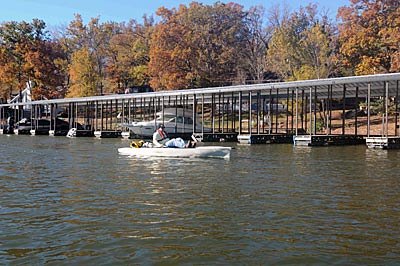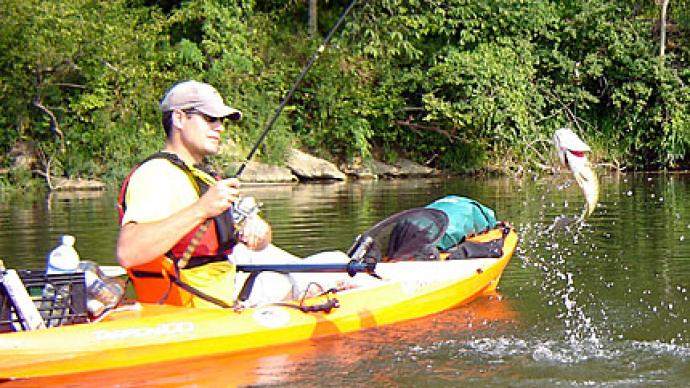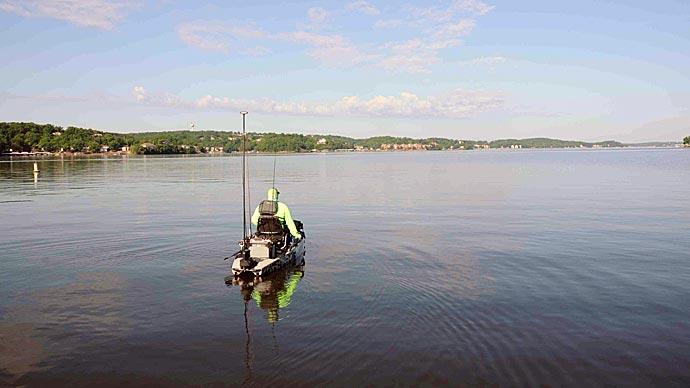
Bass anglers are discovering they can now fish competitively without buying an expensive bass boat.
The growth of kayak bass fishing in the past ten years has resulted from tournament circuits holding events for kayak owners. “The thing about the kayak world is it started coastal,” says Keeton Eoff, Hobie Cat Company director of global strategy and development. “I think a lot of that is that traditional tournament fishing was so ingrained in the middle of the U.S., and kayaks didn’t have livewells. So it wasn’t easily adopted. Now they have the CPR format of catch, photograph, and release, which makes it more appealing.”
Kayak manufacturers are also making boats designed explicitly with bass anglers in mind. “You have got everything in a kayak that you have in a bass boat,” Eoff says. “You‘ve got horizontal rod holders, integrated tackle systems, deep storage, and now the peddle drives allow companies to build a kayak with a large enough platform that is stable so you can stand up in it. It is a game changer when you can stand up and fish.”
Other fishing companies have also contributed to the growth of kayak bass fishing. “Top-level manufacturers have begun making products specifically to enhance the sport of kayak fishing,” Eoff says. “There are affordable fish finders for the kayak, and Power Pole now has a micro anchor for kayaks to hold in place.”
Bass anglers should look at some key features when shopping for a good fishing kayak. “The number one thing you should look for in a bass kayak is stability (for standing up in the kayak),” Eoff says. “Go with a peddle drive which more companies are starting to offer. Mainly, you want the peddle drive to keep your hands free. You don’t want to paddle around while trying to fish.”
Deep storage is also a vital feature of a bass kayak. “There is one thing every bass fisherman in the world carries, and that is more gear than he ever needs, whether in a 22-foot bass boat or a 10-foot kayak,” Eoff says. “You are going to carry more gear than you need.”
Seating is also an important consideration. “The ability to sit high and stand up goes hand-in-hand,” Eoff says. “It is hard to stand up if you have a real low seating position at the bottom of the kayak. But if you have an elevated seat, it's real easy to stand up.”

Bass kayaks range in price depending on whether you buy an entry-level kayak such as the Hobie Mirage Compass with the pedal drive system and plenty of storage room or the cutting-edge Hobie Mirage Pro Angler 14 decked out with forward and reverse pedal drive, lumbar support seating, and dry storage compartments. Eoff says the Compass sells for about $1,995 and the Pro Angler 14 is around $3,650.
Matching a kayak with the vehicle you intend to haul the boat with is another critical consideration. Eoff suggests if you own a small car, you will need to buy a smaller kayak such as the 12-foot Compass. The larger Hobie Pro Angler 14 can be hauled on a trailer or in the bed of your truck with a bed extender such as a Yakima LongArm Truck Bed Extender.
A fishing kayak allows bass anglers to fish anywhere a bass boat can go and many remote areas inaccessible to bass boats. “It is possible to travel 8 or 10 miles in a day fishing in a kayak,” Eoff says.
Eoff claims he loads his kayak with as much tackle as he usually carries in a bass boat. “I consider myself a minimalist,” he says. “I usually take four rods. Out of those four rods, I will have one good light spinning rod, a 6-foot, 8-inch worm rod, a good general casting rod, and whatever rod I can throw a topwater well on.” He uses the spinning rod for wacky-rigged worms and Senkos and the general casting rod for spinnerbaits.
The Texas angler carries a Plano tackle bag filled with six 3700 plastic utility boxes on his kayak. He stows two boxes under his seat and stores some smaller boxes loaded with hooks and weights in the kayak’s front hatch.
Eoff says that 90 percent of the time, he likes to fish Senkos or plastic craws in basic colors when in his kayak. “Any color will work as long as it is green pumpkin,” he says. His tackle bag is usually loaded with ten bags of green pumpkin Senkos and ten bags of green pumpkin or pumpkinseed Berkley Chigger Craws.
Eoff’s hard bait choices for kayak bass fishing include lipless crankbaits (in the spring), a “nice selection” of spinnerbaits, and topwater lures such as Heddon Zara Spooks and Rebel Pop-Rs. “I don’t throw a ton of crankbaits from the kayak because you need that casting leverage for distance, and that is a little harder to do (in a kayak),” he says.
For bass anglers wanting to find remote areas to fish from a kayak, Eoff recommends joining a kayak bass club or checking out Facebook groups devoted to kayak bass fishing.
BassResource may receive a portion of revenues if you make a purchase using a link above.




